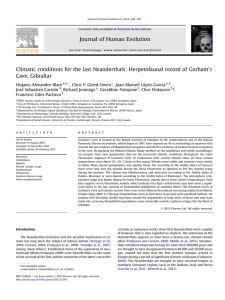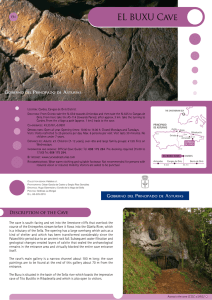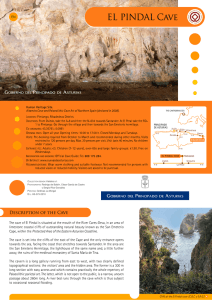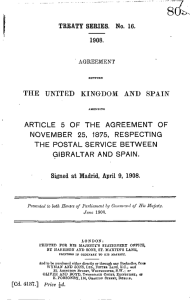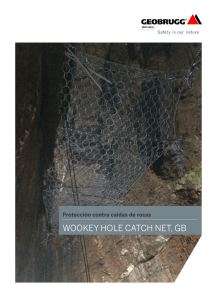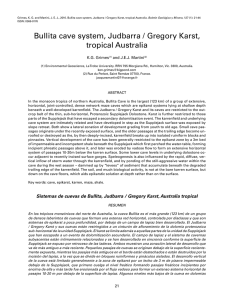Gorham`s Cave, Gibraltar—The persistence of a Neanderthal
Anuncio
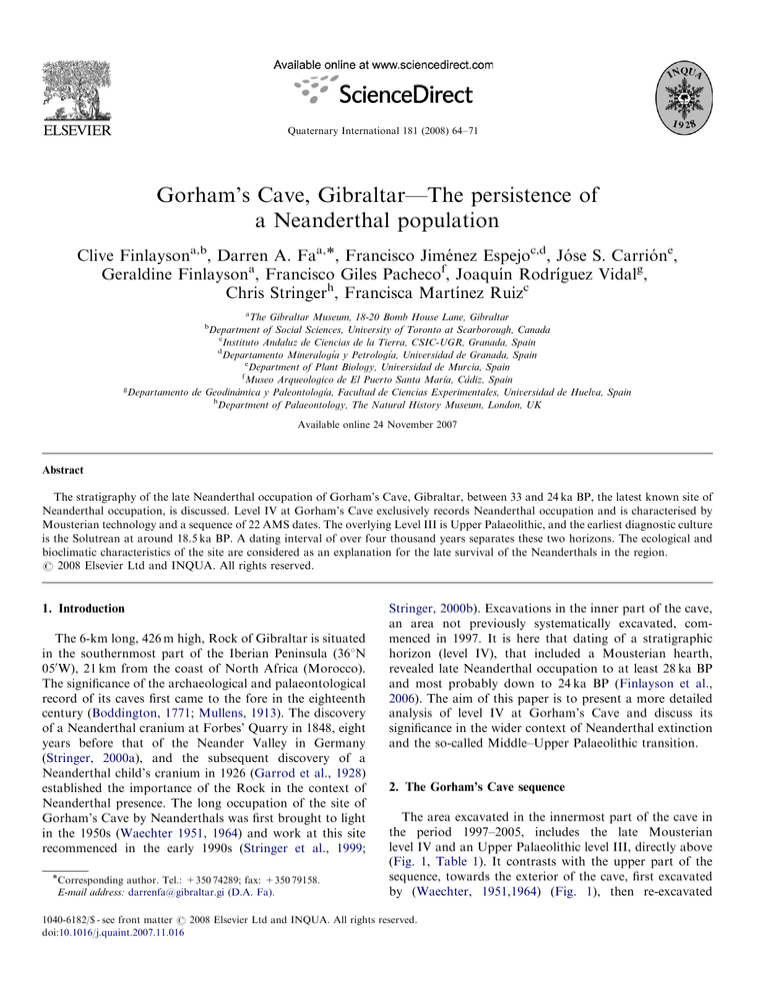
ARTICLE IN PRESS Quaternary International 181 (2008) 64–71 Gorham’s Cave, Gibraltar—The persistence of a Neanderthal population Clive Finlaysona,b, Darren A. Faa,, Francisco Jiménez Espejoc,d, Jóse S. Carrióne, Geraldine Finlaysona, Francisco Giles Pachecof, Joaquı́n Rodrı́guez Vidalg, Chris Stringerh, Francisca Martı́nez Ruizc a The Gibraltar Museum, 18-20 Bomb House Lane, Gibraltar Department of Social Sciences, University of Toronto at Scarborough, Canada c Instituto Andaluz de Ciencias de la Tierra, CSIC-UGR, Granada, Spain d Departamento Mineralogı´a y Petrologı´a, Universidad de Granada, Spain e Department of Plant Biology, Universidad de Murcia, Spain f Museo Arqueologico de El Puerto Santa Marı´a, Cádiz, Spain g Departamento de Geodinámica y Paleontologı´a, Facultad de Ciencias Experimentales, Universidad de Huelva, Spain h Department of Palaeontology, The Natural History Museum, London, UK b Available online 24 November 2007 Abstract The stratigraphy of the late Neanderthal occupation of Gorham’s Cave, Gibraltar, between 33 and 24 ka BP, the latest known site of Neanderthal occupation, is discussed. Level IV at Gorham’s Cave exclusively records Neanderthal occupation and is characterised by Mousterian technology and a sequence of 22 AMS dates. The overlying Level III is Upper Palaeolithic, and the earliest diagnostic culture is the Solutrean at around 18.5 ka BP. A dating interval of over four thousand years separates these two horizons. The ecological and bioclimatic characteristics of the site are considered as an explanation for the late survival of the Neanderthals in the region. r 2008 Elsevier Ltd and INQUA. All rights reserved. 1. Introduction The 6-km long, 426 m high, Rock of Gibraltar is situated in the southernmost part of the Iberian Peninsula (361N 050 W), 21 km from the coast of North Africa (Morocco). The significance of the archaeological and palaeontological record of its caves first came to the fore in the eighteenth century (Boddington, 1771; Mullens, 1913). The discovery of a Neanderthal cranium at Forbes’ Quarry in 1848, eight years before that of the Neander Valley in Germany (Stringer, 2000a), and the subsequent discovery of a Neanderthal child’s cranium in 1926 (Garrod et al., 1928) established the importance of the Rock in the context of Neanderthal presence. The long occupation of the site of Gorham’s Cave by Neanderthals was first brought to light in the 1950s (Waechter 1951, 1964) and work at this site recommenced in the early 1990s (Stringer et al., 1999; Corresponding author. Tel.: +350 74289; fax: +350 79158. E-mail address: darrenfa@gibraltar.gi (D.A. Fa). Stringer, 2000b). Excavations in the inner part of the cave, an area not previously systematically excavated, commenced in 1997. It is here that dating of a stratigraphic horizon (level IV), that included a Mousterian hearth, revealed late Neanderthal occupation to at least 28 ka BP and most probably down to 24 ka BP (Finlayson et al., 2006). The aim of this paper is to present a more detailed analysis of level IV at Gorham’s Cave and discuss its significance in the wider context of Neanderthal extinction and the so-called Middle–Upper Palaeolithic transition. 2. The Gorham’s Cave sequence The area excavated in the innermost part of the cave in the period 1997–2005, includes the late Mousterian level IV and an Upper Palaeolithic level III, directly above (Fig. 1, Table 1). It contrasts with the upper part of the sequence, towards the exterior of the cave, first excavated by (Waechter, 1951,1964) (Fig. 1), then re-excavated 1040-6182/$ - see front matter r 2008 Elsevier Ltd and INQUA. All rights reserved. doi:10.1016/j.quaint.2007.11.016 ARTICLE IN PRESS C. Finlayson et al. / Quaternary International 181 (2008) 64–71 subsequently between 1991 and 1997 (Pettitt and Bailey, 2000). Zilhao and Pettitt (2006) located this excavation towards the cave interior when it was actually in the part of the cave that is more exposed to external conditions and is heavily bioturbated in places. The sedimentary environment in this part has been contributed by an aeolian infill formed by coastal dune sands that penetrated upwards towards the interior of the cave. This created a sloping Fig. 1. Plan of Gorham’s Cave, Gibraltar. Black ellipse (marked by A) is area in interior of cave excavated in period 1997–2005 and the area of late Neanderthal occupation. Grey ellipse (marked by B) is area excavated prior to 1999 by Waechter and later the Gibraltar Caves Project team, including Pettitt (erroneously marked in Zilhao and Pettitt, 2006). 65 entrance, with a strong gradient (15–201), in places sandy in nature and soft, with its sedimentary stratigraphy showing evidence of disturbance by animals and hominins. The deep part of the cave, however, is a depositional surface, with subhorizontal stratigraphy and lower sand content. The main post-depositional effects are, therefore, compaction through trampling, rather than bioturbation. The stratigraphic integrity of level IV is beyond question on scientific grounds (Finlayson et al., 2006). Table 1 summarises the AMS dates obtained for level IV and contrasts it with level III, directly above it. There is therefore complete independence of the two levels on dating, cultural, mineralogical, geochemical and stratigraphic grounds. The position is strengthened further by the total absence of any pre-Solutrean Upper Palaeolithic technologies anywhere in the stratigraphy. The sequence of dates obtained were from significant pieces of charcoal (mean weight ¼ 2.04 g, standard deviation 3.13) and corresponds closely with the archaeological sequence for the region. Here there is a general absence of Aurignacian (with the possible exception of the site of Bajondillo, Cortés Sánchez, 2007), and the Gravettian is rare (Ferreira Bicho, 2005), which appears concomitant with a late Mousterian presence instead. The dates within level IV do not appear in perfect stratigraphic sequence, as clearly shown and explained by Finlayson et al. (2006). The results obtained were, however, consistent with expectation of a level that had repeatedly been visited and re-occupied by generations of Neanderthals. The repeated use of one place as a hearth implies the removal of previous materials. These people would have disturbed the floor used and fires made by their predecessors when they occupied the site, so although a general temporal sequence of dates would be expected (as is the case with the chronology from Gorham’s), it would be unrealistic to expect a perfect and precise stratigraphic sequence of charcoals and corresponding dates in fine detail. This kind of disturbance is very characteristic and the case in most Palaeolithic sites. It is well known on the basis of present models and other archaeological localities (e.g., Valverdú et al., 2005; Sergeant et al., 2006). This disturbance implies a minor Table 1 Distribution of AMS dates from Gorham’s Cave, Levels III and IV Level III Level IV K/ Al La/ Lu Number of AMS Dates o24 kyr bp Number of AMS dates 4 24 kyr bp Youngest Date (lower 95% confidence limit) Oldest Date (upper 95% confidence limit) Number of mousterian artefacts present Number of upper Palaeolithic artefacts present Mg/ Al 8 0 0 22 10 800 23 040 18 600 33 340 0 103 240 0 0.285 0.70 117.1 0.175 0.555 125.0 The difference between levels III and IV are highly significant: Fisher exact test, po0.00001. In the extreme situation presented, with the lowest 95% confidence limit for level IV contrasted with the oldest confidence limit for level III the age hiatus between the levels is 4,440 years. Any question of contamination of charcoal from level III into level IV is therefore discarded. These dates are supported by the completely separate geochemical signals identified for the two levels (this table and Finlayson et al. 2006 for details). There is furthermore a complete technological separation between the levels (Fisher exact test, po0.00001). Average values. ARTICLE IN PRESS 66 C. Finlayson et al. / Quaternary International 181 (2008) 64–71 vertical disturbance and horizontal re-distribution of combustion remains that avoid a perfect vertical chronostratigraphic sequence. The key question is the degree of stratigraphic integrity of level IV compared with the level directly above. The apparent absence of human activity for over four thousand years after the last Middle Palaeolithic occupation suggests Neanderthal abandonment of the site, or their extinction, which left level IV undisturbed. Subsequent, and apparently sporadic, occupation by modern humans did not intrude into level IV. Thus no Upper Palaeolithic artefacts appear in level IV, there are no charcoals dating to the Solutrean in level IV, and the mineralogical/geochemical signature is completely distinct. The use of geochemical ratio for materials characterisation is a well-developed technique (e.g., Romano et al., 2006). Levels IV and III originated by a combination of inorganic and organic inputs, and cultural artefacts. Inorganic input to the cave is associated with autochthonous cave minerals originating through calcite dissolution (the so-called ‘‘terra rossa’’), and external inputs. External inputs are mainly related to aeolian input and surface or near-surface materials occurring around the cave, usually after suffering a certain degree of pedogenesis (Ellwood et al., 2001, 2004). A priori, the conditions of formation of every level must be unique and will generate a characteristic geochemical imprint that could be relatively homogeneous across levels or at least show variations following gradual tendencies. Detrital proxies, in particular, tend to exhibit highly homogeneous values along similar stratigraphic levels. Among others, lateral progressive variations from entrance to deep locations, local disturbances, and diagenetic effects, could all affect the interpretation of the geochemical proxies. In any case, at Gorham’s Cave the hiatus between levels III and IV is confirmed following geochemical analysis in three separate excavation fronts (see Finlayson et al., 2006 for details), representing different depositional conditions. After analyzing major and trace elements, diverse detrital proxies have been investigated and Mg/Al, K/Al and La/Lu ratios (Table 1) have been selected as the most informative. In both levels the mineralogical phases associated with Mg and K have a detrital origin (chlorite, dolomite and ankerite as Mg sources and illite and K-feldspars for K). The other detrital proxy used, the La/Lu ratio (e.g., Hamroush and Stanley, 1990; MartinezRuiz et al., 2000), is related with the source of sediments. For level IV, the Mg/Al ratio ranged from 0.17 to 0.18 and from 0.55 to 0.56 for K/Al ratio (Table 1). At level IIIB Mg/Al ranged from 0.27 to 0.30, two times higher than level IV, and the K/Al ratio ranged from 0.69 to 0.71. The La/Lu ratio at level IV ranged from 124.5 to 125.5 and for the level III from 114.1 to 123.7 with an average value of Fig. 2. Spider diagram of the mean concentrations of trace elements at different levels; n ¼ 3, in ppm. K ¼ level IIIA, ~ ¼ level IIIB, m ¼ level IV. Note level III is distinguished between the upper part (A) and the lower part (B) that is closest to level IV. ARTICLE IN PRESS C. Finlayson et al. / Quaternary International 181 (2008) 64–71 117.1 (Table 1). These clear differences between levels have been also confirmed by the chemical characteristics of sediments (Fig. 2). The high resolution geochemical mapping developed using Tatscanner F-2 (Sakamoto et al., 2006) at each of the different cave levels indicate a laminar/subhorizontal (discarding brecciated or chaotic) deposition (Finlayson et al., 2006). All these geological data indicate a distinctive and highly homogeneous bed deposition for several geochemical ratios at each separate level, a relatively common phenomenon in caves with low levels of disturbance (e.g., Forbes and Bestland, 2007). Finally, the suggestion of contamination of 24–30 ka BP charcoals from level III into level IV (Zilhao and Pettitt, 2006) begs the obvious question—why were no 24–30 ka BP charcoals found in level III? It seems very unlikely that all the 24–30 ka BP charcoals filtered down into level IV, leaving none behind in level III, and seems equally unlikely that no older charcoals migrated up into level III. In total, the Gorham’s Cave stratigraphy represents a sequence of about 18 m, covering the period from the Last Interglacial (Rodrı́guez-Vidal et al., 2007) to the Last Glacial Maximum and beyond, into the Neolithic and Protohistoric periods (Finlayson, 2006). However, regarding level IV, our previous conclusion seems the most reasonable: this was the uppermost part of a long sequence of occupation of Gorham’s Cave by Neanderthals. The cave was not a refugium but rather a favoured habitation for the Neanderthals and the optimal conditions of the site and surrounding region enabled persistence of this population. In our view there is nothing diagnostically Aurignacian nor Gravettian in the sequence and there are no radiocarbon dates falling in the period 24–18.5 ka BP. The site was then occupied in the Solutrean after 18.5 ka BP. To suggest that dates in the 24–30 ka BP range were related to modern human activity would therefore require either: (a) that all 24–30 ka BP charcoals had percolated into level IV from level III without leaving any behind in level III; or (b) that the Solutrean culture here commenced in the period 24–30 ka BP , thousands of years before its commencement in the rest of southern Iberia. Even then, the Solutrean artefacts did not percolate into level IV while all the charcoals did; or (c) that people (Aurignacian or Gravettian or both) entered the cave between 24 and 30 ka BP, made fires, consumed animals, but left no artefacts in level IV. Tools attributed to the early Upper Palaeolithic were described by Waechter (1951, 1964) and reported (though not described) by Pettitt and Bailey (2000). These may well have been the products of Neanderthals, or of later Upper Palaeolithic modern humans. Alternatively, since these tools were recovered towards the front of the cave, it remains theoretically possible that there were sporadic visits by early Upper Palaeolithic humans who did not access the rear of the 67 cave, and impact the Neanderthal occupations in level IV. However, this possibility would require much more evidence before it could be seriously considered. 3. Why did Neanderthals survive late in Gorham’s Cave? The answer seems to lie in the ecological diversity of the environment that the Neanderthals exploited outside Gorham’s Cave. To date, in level IV, two species of amphibian, seven reptiles, 11 large mammals and 44 bird species have been identified (Finlayson et al., 2006). At least 10 species of intertidal and shallow water molluscs have also been identified (Fa, in press). The flora and vegetation of the Gibraltar region and surrounding mountains also reveal great diversity within a small area (Carrión et al., 2005, in press; Finlayson et al., 2006; Finlayson and Carrión, 2007). It is this small scale mosaic of diversity, combining rocky habitat, open woodland, wetland and coast, which offered the Neanderthals opportunities for year-round subsistence, a strategy that they had successfully pursued for over 100 thousand years (Finlayson, 2006). Such a strategy was pursued in mild Mediterranean bioclimatic conditions that strayed little beyond the range covered by thermo- and meso-Mediterranean thermotypes and subhumid and dry ombrotypes, with mean annual temperatures oscillating between 13 and 17 1C and annual rainfall between 350 and 1000 mm (Finlayson, 2006). Such conditions also appear to have pertained to the Solutrean occupation during OIS 2 (Finlayson et al., 2007). 4. What killed off the last Neanderthals? Jiménez-Espejo et al. (2007) have shown that the most inhospitable conditions of the previous 250 ka BP affected the region surrounding Gibraltar between 22.5 and 25.5 ka cal BP (dates were calibrated to allow direct comparison with marine core sequences) and have linked this with unstable conditions, extremely cold, arid and highly variable related to Heinrich event 2 (HE2) that led to the final disappearance of the Neanderthals. This study was based on new data from marine cores as well as an extensive literature concerning marine palaeoenviromental reconstructions (e.g., Cacho et al., 2002; Martrat et al., 2004; Moreno et al., 2005). We suggest that this event, particularly severe and short-lived around 24 ka cal BP, would have been sufficient to kill off any surviving Neanderthals. At the population level, the process must have been spatially heterogeneous within southern Iberia (Finlayson and Carrión, 2007), and we may well keep the expectation that other populations will be dated between the most recent part of MIS3 and onset of MIS2. On this basis, it is not surprising that (subject to confirmation from further excavations) new dating results from Neanderthal-bearing beds in Carihuela Cave, northwards from Gibraltar in ARTICLE IN PRESS 68 C. Finlayson et al. / Quaternary International 181 (2008) 64–71 continental Andalucı́a, fall within the 28–22 ka BP span (Fernández et al., 2007). argument that it represented widespread admixture now becomes increasingly difficult to sustain. 5. Discussion 5.2. There was no Ebro Frontier 5.1. Late southern Iberian Neanderthals—implications for the Lagar Velho child Much has been made of an apparent division of occupation of the Iberian Peninsula into that north of the Ebro River (largely occupied by Aurignacian modern humans) and south of it (largely occupied by Neanderthals) until 30–20 ka BP (Zilhao, 2000). However, recent work has provided evidence that the apparent stasis for five thousand years across the so-called Ebro stable biocultural frontier is an artefact of the dates chosen to represent each side of the division. There were, in fact, modern humans south of this frontier and Neanderthals north of it during the presumed frontier period between 35 and 30 ka BP (Finlayson, 2004; Vaquero et al., 2006). The processes of Neanderthal extinction and modern human colonisation are a major bone of contention. These processes may be viewed as independent events in which Neanderthal populations survived longest in the thermoand meso-Mediterranean zones of southern Iberia, particularly the south-west and south-east (Finlayson, 2006), with a slow entry into Mediterranean zones of modern humans from the Eurosiberian region to the north (Fig. 3). Zilhao and Pettitt (2006) interpret the statement by Finlayson et al. (2006) that during the transition between the Middle and Upper Palaeolithic in southern Iberia human populations were at low densities, to estimate that the remaining Neanderthal population needed a minimum land area of 50,000 km2 (at a population density of a single The publication of the discovery of a juvenile human from the Gravettian period at the site of Lagar Velho, Portugal (Duarte et al., 1999) raised the possibility of hybridisation among Neanderthals and modern humans. That the Lagar Velho child was a hybrid at all has been seriously contested (e.g. see Tattersall and Schwartz, 1999). In any case, to base a taxonomic claim on a single, juvenile, specimen is difficult especially since the body proportion data potentially lie within the expected Gravettian range. Additionally, Pettitt et al. (2002) subsequently placed the age of the burial between 24 and 25 ka BP, relatively late for a Gravettian burial. The late date of the burial, supposedly long after the last Neanderthals had disappeared from Iberia, led to the argument that hybridisation must have been widespread among Neanderthals and modern humans for such mosaic features to survive so recently in an individual (Zilhao and Trinkaus, 2002). The findings related to level IV at Gorham’s Cave suggest that the Lagar Velho child could have been contemporaneous with the southern Iberian Neanderthals, but we have no evidence of how far north any surviving Neanderthals extended. Even accepting the contentious position of the individual being a hybrid, the Fig. 3. Distribution of major bioclimatic belts of the Iberian Peninsula (from Finlayson, 2004). White—Eurosiberian; pale grey-oro-Mediterranean; grey—supra-Mediterranean; dark grey-meso-Mediterranean; and black-thermo-Mediterranean. ARTICLE IN PRESS C. Finlayson et al. / Quaternary International 181 (2008) 64–71 69 60000 OIS 3 50000 H5 Years BP 40000 H4 30000 H3 20000 H2 OIS 2 H1 10000 YD 95% cl Upper OIS 1 0 95% cl Lower Date BP Fig. 4. Distribution of 63 AMS dates for Gorham’s Cave, Gibraltar. Dotted lines mark the position of cold Heinrich (H) events and the Younger Dryas (YD). Oxygen Isotope Stages (OIS) are separated by solid lines. Neanderthal for every 100 km2). Based on this hypothetical model they go on to state that Neanderthals and Moderns in this region must have lived in total sympatry, with extensively overlapping mating networks, and query how no exchange of genes or culture could have resulted. In the first instance, there is no requirement for a minimum population size of 500 individuals since we know that the existing Neanderthal population eventually went extinct. Secondly, their model ignores the spatio-temporal mosaic that is an intrinsic part of Finlayson et al.’s scenario. By failing to consider the extremely heterogeneous nature of the southern Iberian Peninsula and the generally accepted premise that these humans would have moved around this environment in small, possibly family, groups, both factors that would have significantly decreased encounter rates, they provide a model that is unrealistic. At Gorham’s Cave, in the extreme south, events are seen in terms of regular periods of occupation by Neanderthals, interrupted at times that in some cases at least can be related to cool periods associated with Heinrich (HE) Events. By HE2 the last Neanderthals had left the cave, (Fig. 4), but on this occasion they did not return. Subsequent visits by modern humans later appear much more sporadic. These fluctuating periods of occupation of the cave were independent of modern humans, who were not in the area for the greater part of the time. As we move north-eastwards and Mediterranean and Eurosiberian zones are compressed more closely (Fig. 3), the probability of contact between the populations is greater, thus providing a functional explanation for the strikingly different patterns observed in Cataluña and Cantabria (Vaquero et al., 2006) when compared to the deep south. It was in the extreme south-west, the haven within the refugium, that the last Neanderthals survived. References Boddington, J., 1771. Account of some Bones found in the Rock of Gibraltar, in a Letter from John Boddington Esq.; to Dr William Hunter, F.R.S., with some Remarks from Dr Hunter in a Letter to Dr Matthew Maty, M.D., Sec. R.S. Philosophical Transactions of the Royal Society of London, vol. 60, pp. 414–416. Cacho, I., Grimalt, J.O., Canals, M., 2002. Response of the Western Mediterranean Sea to rapid climatic variability during the last 50,000 years: a molecular biomarker approach. Journal of Marine Systems 33–34, 253–272. Carrión, J.S., Fuentes, N., Garcia, M.S., González-Sampériz, P., Finlayson, C., Riquelme, J.A., 2005. Pollen analysis of Coprolites from Gorham’s Cave depicts mosaic Pleistocene landscapes in Gibraltar. In: Rodrı́guez Vidal, J., Finlayson, C., Giles Pacheco, F. (Eds.), Cuaternario Mediterraneo y Poblamiento de Hominidos. AEQUA, Gibraltar. Carrión, J.S., Finlayson, C., Fuentes, N., Finlayson, G., Fernández, S., Allué, E., López-Sáez, A., López-Garcı́a, P., González-Sampériz, P., in press. A coastal reservoir of biodiversity for Upper Pleistocene human populations. In: Finlayson, C., Bailey, G., Carrión, J.S., Rodrı́guezVidal, J., (Eds.), The Coastal Shelf in the Mediterranean and Beyond. Corridor and Refugium for Human Populations in the Pleistocene. Quaternary Science Reviews Special Volume. ARTICLE IN PRESS 70 C. Finlayson et al. / Quaternary International 181 (2008) 64–71 Cortés Sánchez, M. (Ed.), 2007. Cueva Bajondillo (Torremolinos). Secuencia cronocultural y paleoambiental del Cuaternario reciente en la Bahı́a de Málaga. Diputación de Málaga, Málaga. Duarte, C., Mauricio, J., Pettitt, P.B., Souto, P., Trinkaus, E., van der Plicht, H., Zilhao, J., 1999. The early Upper Palaeolithic human skeleton from the Abrigo do Lagar Velho (Portugal) and modern human emergence in Iberia. Proceedings of the National Academy of Sciences, USA 96, 7604–7609. Ellwood, B.B., Harrold, F.B., Benoist, S.L., Straus, L.G., GonzalezMorales, M., Petruso, K., Bicho, N.F., Zilhao, Z., Soler, N., 2001. Paleoclimate and intersite correlations from Late Pleistocene/Holocene cave sites: results from southern Europe. Geoarchaeology 16, 433–463. Ellwood, B.B., Harrold, F.B., Benoist, S.L., Thacker, P., Otte, M., Bonjean, D., Long, G.L., Shahin, A.M., Hermann, R.P., Grandjean, F., 2004. Magnetic susceptibility applied as an age-depth-climate relative dating technique using sediments from Scladina Cave, a late Pleistocene cave site in Belgium. Journal of Archaeological Science 31, 283–293. Fa, D.A., in press. A report on the marine mollusca from the Gorham’s Cave excavations, 1998–2005: preliminary results and interpretation. In: Finlayson, C., Rodrı́guez Vidal, J., Giles Pacheco, F. (Eds.), Where the Last Neanderthals Lived. Oxbow Books, Oxford. Fernández, S., Carrión, J.S., Fuentes, N., González-Sampériz, P., Montoya, E., Gil Romera, G., Vega Toscano, L.G., Riquelme, J.A., 2007. Palynology of carihuela cave, southern Spain: completing the record. Geobios 40, 75–90. Ferreira Bicho, N., 2005. The extinction of Neanderthals and the emergence of the Upper Paleolithic in Portugal. Promontoria 3, 173–228. Finlayson, C., 2004. Neanderthals and Modern Humans: An Ecological and Evolutionary Perspective. Cambridge University Press, Cambridge. Finlayson, C., Carrión, J.S., 2007. Rapid ecological turnover and its impact on Neanderthal and other human populations. Trends in Ecology and Evolution 22, 213–222. Finlayson, G., 2006. Climate, vegetation and biodiversity—a multiscale study of the south of the Iberian Peninsula. Ph.D. Thesis, Anglia Ruskin University, Cambridge. Finlayson, C., Giles Pacheco, F., Rodrı́guez-Vidal, J., Fa, D.A., Gutierrez López, J.M., Santiago Pérez, A., Finlayson, G., Allué, E., Baena Preysler, J., Cáceres, I., Carrión, J.S., Fernández Jalvo, Y., GleedOwen, C.P., Jimenez Espejo, F., López, P., López Sáez, J.A., Riquelme Cantal, J.A., Sánchez Marco, A., Giles Guzman, F., Brown, K., Fuentes, N., Valarino, C.A., Villalpando, A., Stringer, C.B., Martinez Ruiz, F., Sakamoto, T., 2006. Late survival of Neanderthals at the southernmost extreme of Europe. Nature 443, 850–853. Finlayson, G., Finlayson, C., Giles Pacheco, F., Rodrı́guez Vidal, J., Carrión, J.S., Recio Espejo, J.M., 2007. Caves as archives of ecological and climatic changes in the Pleistocene—the case of Gorham’s Cave, Gibraltar. Quaternary International, this volume, doi:10.1016/j.quaint. 2007.01.009. Forbes, M.S., Bestland, E.A., 2007. Origin of the sedimentary deposits of the Naracoorte Caves, South Australia. Geomorphology 86, 369–392. Garrod, D., Buxton, L., Elliot-Smith, G., Bate, D., 1928. Excavation of a Mousterian rock-shelter at Devil’s Tower, Gibraltar. Journal of the Royal Anthropological Institute 58, 33–113. Hamroush, H.A., Stanley, A.D.J., 1990. Paleoclimatic oscillations in East Africa interpreted by analysis of trace elements in Nile delta sediments. Episodes 13, 264–269. Jiménez-Espejo, F.J., Martı́nez-Ruiz, F., Finlayson, C., Paytane, A., Sakamoto, T., Ortega-Huertas, M., Finlayson, G., Iijimaf, K., Gallego-Torres, D., Fa, D., 2007. Climate forcing and Neanderthal extinction in southern Iberia: insights from a multiproxy marine record. Quaternary Science Reviews 26, 836–852. Martinez-Ruiz, F., Kastner, M., Paytan, A., Ortega-Huertas, M., Bernasconi, S.M., 2000. Geochemical evidence for enhanced productivity during S1 sapropel deposition in the eastern Mediterranean. Paleoceanography 15 (2), 200–209. Martrat, B., Grimalt, J.O., Lopez-Martinez, C., Cacho, I., Sierro, F.J., Flores, J.A., Zahn, R., Canals, M., Curtis, J.H., Hodell, D.A., 2004. Abrupt temperature changes in the Western Mediterranean over the Past 250,000 years. Science 306, 1762–1765. Moreno, A., Cacho, I., Canals, M., Grimalt, J.O., Sánchez-Goñi, M.F., Shackleton, N., Sierro, F.J., 2005. Links between marine and atmospheric processes oscillating on a millennial time-scale. A multiproxy study of the last 50,000 yr from the Alboran Sea (Western Mediterranean Sea): Quaternary land–ocean correlation. Quaternary Science Reviews 24, 1623–1636. Mullens, W.H. (Ed.), 1913. The Introduction to Fauna Calpensis (A Natural History of Gibraltar and southern Spain) by John White. The Selborne Society, London, p. 24. Pettitt, P.B., Bailey, R.M., 2000. AMS radiocarbon and luminescence dating of gorham’s and vanguard caves, gibraltar, and implications for the middle to upper palaeolithic transition in Iberia. In: Stringer, C.B., Barton, R.N.E., Finlayson, C. (Eds.), Neanderthals on the Edge. Oxbow Books, Oxford, pp. 155–162. Pettitt, P.B., van der Plicht, H., Bronk Ramsey, C., Monge Soares, A.M., Zilhao, J., 2002. The Radiocarbon Chronology. In: Zilhao, J., Trinkaus, E., (Eds.), Portrait of the Artist as a Child. The Gravettian Human Skeleton from the Abrigo do Lagar Velho and its Archaeological Context. Trabalhos de Arqueologia, 22, pp. 132–138. Rodrı́guez-Vidal, J., Cáceres, L.M., Abad, M., Ruiz, F., y Martı́nezAguirre, A., 2007. Morphosedimentary evidences of the last interglacial maximum on the coast of Governor’s Beach, Gibraltar. Geogaceta 42, 107–110. Romano, F.P., Pappalardo, G., Pappalardo, L., Garraffo, S., Gigli, R., Pautasso, A., 2006. Quantitative non-destructive determination of trace elements in archaeological pottery using a portable beam stability-controlled XRF spectrometer. X-ray Spectrometry 35, 1–7. Sakamoto, T., Kuroki, K., Sugawara, T., Aoike, K., Iijima, K., Sugisaki, S., 2006. Non-destructive X-ray fluorescence (XRF) core imaging scanner, ‘TATSCAN-F2’ for the IODP science, scientific drilling. Integrated ODP 2, 37–39. Sergeant, J., Crombé, P., Perdaen, Y., 2006. The ‘invisible’ hearths: a contribution to the discernment of Mesolithic non-structured surface hearths. Journal of Archaeological Sciences 33, 999–1007. Stringer, C., 2000a. Gibraltar and the Neanderthals 1848–1998. In: Stringer, C.B., Barton, R.N.E., Finlayson, J.C. (Eds.), Neanderthals on the Edge. Oxbow Books, Oxford. Stringer, C., 2000b. Gibraltar and the Neanderthals. In: Finlayson, C., Finlayson, G., Fa, D. (Eds.), Gibraltar during the Quaternary. The southernmost part of Europe in the last two million years. Gibraltar Government Heritage Publications, Monographs 1, Gibraltar. Stringer, C.B., Barton, R.N.E., Currant, A.P., Finlayson, J.C., Goldberg, P., Macphail, R., Pettitt, P.B., 1999. Gibraltar Palaeolithic Revisited: New Excavations at Gorham’s and Vanguard Caves. In: Davies, W., Charles, R. (Eds.), Dorothy Garrod and the Progress of the Palaeolithic. Studies in the Prehistoric Archaeology of the Near East and Europe. Oxbow Books, Oxford. Tattersall, I., Schwartz, J., 1999. Hominids and hybrids. The place of Neanderthals in human evolution. Proceedings of the National Academy of Sciences, USA 96, 7117–7119. Valverdú, J., Allué, E., Bischoff, J.L., Cáceres, I., Carbonell, E., Cebrià, A., Garcia-Antón, D., Hugueta, R., Ibáñez, N., Martı́nez, K., Pastó, I., Rosella, J., Saladié, P., Vaquero, M., 2005. Short human occupations in the Middle Palaeolithic level i of the Abric Romanı́ rock-shelter (Capellades, Barcelona, Spain). Journal of Human Evolution 48, 157–174. Vaquero, M., Maroto, J., Arrizabalaga, A., Baena, J., Baquedano, E., Carrión, E., Jorda, J.F., Martinon, M., Menendez, M., Montes, R., Rossell, J., 2006. The Neanderthal-Modern Human meeting in Iberia: a critical view of cultural, geographical and chronological data. In: Conard, N.J. (Ed.), When Neanderthals and Modern Humans Met. Tubingen, Kerns-Verlag, pp. 419–439. Waechter, J.D’A., 1951. Excavations at Gorham’s Cave, Gibraltar. Proceedings, Prehistorical Society 17, 83–92. ARTICLE IN PRESS C. Finlayson et al. / Quaternary International 181 (2008) 64–71 Waechter, J.D’A., 1964. The excavations at Gorham’s Cave, Gibraltar, 1951–1954. Bulletin, Institute of Archaeology, London 4, 189–221. Zilhao, J., 2000. The Ebro Frontier: a Model for the Late Extinction of Iberian Neanderthals. In: Stringer, C.B., Barton, R.N.E., Finlayson, C. (Eds.), Neanderthals on the Edge. Oxbow Books, Oxford, pp. 111–121. 71 Zilhao, J., Pettitt, P., 2006. On the new dates for Gorham’s Cave and the late survival of Iberian Neanderthals. Before Farming 2006/3, 1–9. Zilhao, J., Trinkaus, E. (Eds.), 2002. Portrait of the Artist as a Child. The Gravettian Human Skeleton from the Abrigo do Lagar Velho and its Archaeological Context. Trabalhos de Arqueologia, vol. 22, p. 609.
